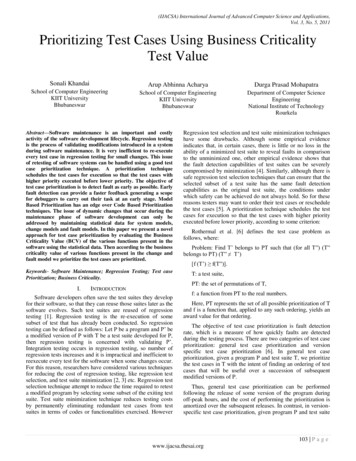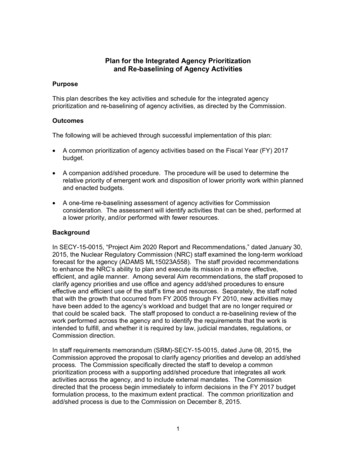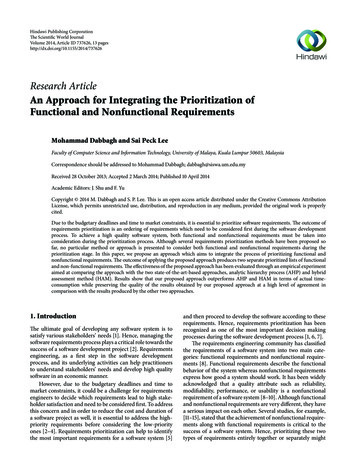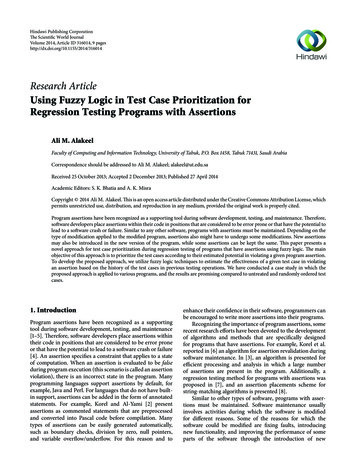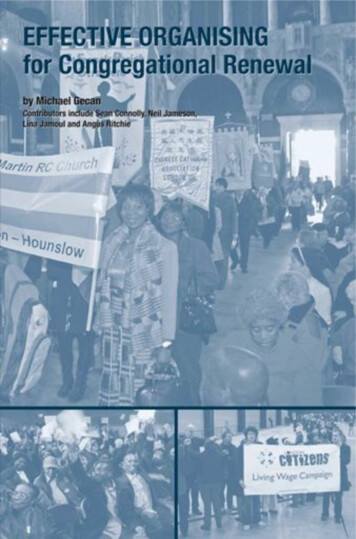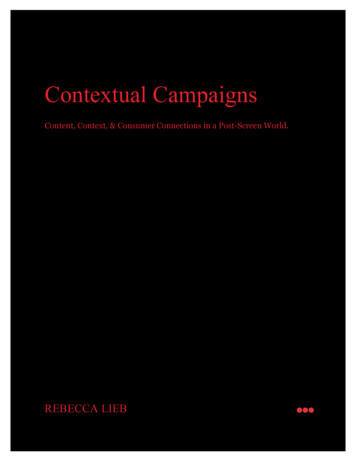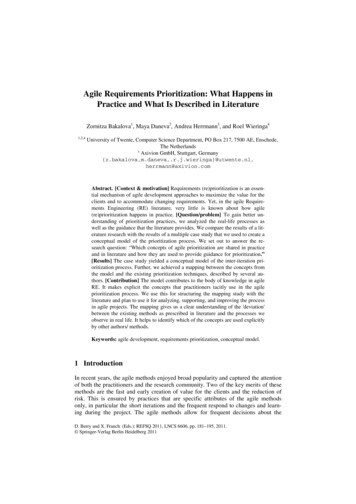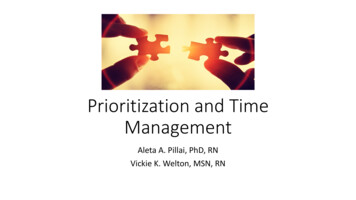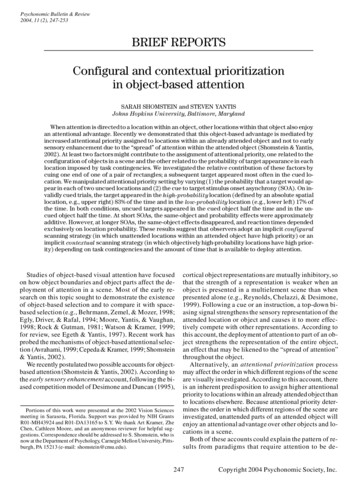
Transcription
Psychonomic Bulletin & Review2004, 11 (2), 247-253BRIEF REPORTSConfigural and contextual prioritizationin object-based attentionSARAH SHOMSTEIN and STEVEN YANTISJohns Hopkins University, Baltimore, MarylandWhen attention is directed to a location within an object, other locations within that object also enjoyan attentional advantage. Recently we demonstrated that this object-based advantage is mediated byincreased attentional priority assigned to locations within an already attended object and not to earlysensory enhancement due to the “spread” of attention within the attended object (Shomstein & Yantis,2002). At least two factors might contribute to the assignment of attentional priority, one related to theconfiguration of objects in a scene and the other related to the probability of target appearance in eachlocation imposed by task contingencies. We investigated the relative contribution of these factors bycuing one end of one of a pair of rectangles; a subsequent target appeared most often in the cued location. We manipulated attentional priority setting by varying (1) the probability that a target would appear in each of two uncued locations and (2) the cue to target stimulus onset asynchrony (SOA). On invalidly cued trials, the target appeared in the high-probability location (defined by an absolute spatiallocation, e.g., upper right) 83% of the time and in the low-probability location (e.g., lower left) 17% ofthe time. In both conditions, uncued targets appeared in the cued object half the time and in the uncued object half the time. At short SOAs, the same-object and probability effects were approximatelyadditive. However, at longer SOAs, the same-object effects disappeared, and reaction times dependedexclusively on location probability. These results suggest that observers adopt an implicit configuralscanning strategy (in which unattended locations within an attended object have high priority) or animplicit contextual scanning strategy (in which objectively high-probability locations have high priority) depending on task contingencies and the amount of time that is available to deploy attention.Studies of object-based visual attention have focusedon how object boundaries and object parts affect the deployment of attention in a scene. Most of the early research on this topic sought to demonstrate the existenceof object-based selection and to compare it with spacebased selection (e.g., Behrmann, Zemel, & Mozer, 1998;Egly, Driver, & Rafal, 1994; Moore, Yantis, & Vaughan,1998; Rock & Gutman, 1981; Watson & Kramer, 1999;for review, see Egeth & Yantis, 1997). Recent work hasprobed the mechanisms of object-based attentional selection (Avrahami, 1999; Cepeda & Kramer, 1999; Shomstein& Yantis, 2002).We recently postulated two possible accounts for objectbased attention (Shomstein & Yantis, 2002). According tothe early sensory enhancement account, following the biased competition model of Desimone and Duncan (1995),Portions of this work were presented at the 2002 Vision Sciencesmeeting in Sarasota, Florida. Support was provided by NIH GrantsR01-MH43924 and R01-DA13165 to S.Y. We thank Art Kramer, ZheChen, Cathleen Moore, and an anonymous reviewer for helpful suggestions. Correspondence should be addressed to S. Shomstein, who isnow at the Department of Psychology, Carnegie Mellon University, Pittsburgh, PA 15213 (e-mail: shomstein@cmu.edu).cortical object representations are mutually inhibitory, sothat the strength of a representation is weaker when anobject is presented in a multielement scene than whenpresented alone (e.g., Reynolds, Chelazzi, & Desimone,1999). Following a cue or an instruction, a top-down biasing signal strengthens the sensory representation of theattended location or object and causes it to more effectively compete with other representations. According tothis account, the deployment of attention to part of an object strengthens the representation of the entire object,an effect that may be likened to the “spread of attention”throughout the object.Alternatively, an attentional prioritization processmay affect the order in which different regions of the sceneare visually investigated. According to this account, thereis an inherent predisposition to assign higher attentionalpriority to locations within an already attended object thanto locations elsewhere. Because attentional priority determines the order in which different regions of the scene areinvestigated, unattended parts of an attended object willenjoy an attentional advantage over other objects and locations in a scene.Both of these accounts could explain the pattern of results from paradigms that require attention to be de-247Copyright 2004 Psychonomic Society, Inc.
248SHOMSTEIN AND YANTISployed to multiple parts of the scene over time (e.g.,Behrmann et al., 1998; Egly et al., 1994; Moore et al.,1998; Watson & Kramer, 1999). However, the two accounts make different predictions under some circumstances. Shomstein and Yantis (2002) asked subjects toidentify a central target while attempting to ignore flanking distractors that were mapped to either a compatible oran incompatible response (following the classic flankersparadigm of Eriksen and colleagues; e.g., Eriksen &Eriksen, 1974). The flanking letters appeared eitherwithin the object occupied by the target or at an equidistant location in a different object. An important featureof this design was that spatial location of the target wasknown with 100% certainty. According to the early sensory enhancement account, attention should “spread”within the attended object so that the flanking letters located in that object should benefit perceptually relativeto objects elsewhere. This account predicts, therefore,that the time to identify the target letter will depend onthe identity (or more precisely on the response compatibility) of the flanking letters to a greater degree whenthey appear in the attended object than when they appearin the unattended object. In contrast, the attentional prioritization account predicts that because the target location is known with 100% certainty, only one locationshould be examined in order to perform the task, so thepriority of other locations in the scene remains near zero.Therefore, this account predicts that flanker interferencewill not depend on whether the flankers occupy the sameor different object as the target (although the absolutespatial separation between the target and flankers maywell affect performance due to spatial “leakage” of attention). The predictions of the prioritization account,and not of the early sensory enhancement account, weresatisfied.A critical further test of the predictions of the two accounts was to reduce target location certainty from 100%to equiprobable among four locations. In this case, multiple locations are potentially relevant, and any objectbased prioritization bias should be evident. Under theseconditions, object-based modulation of the flanker effectwas observed. These results suggest that object-basedselection may reflect an implicit object-specific attentionalprioritization strategy that arises only when multiple locations in the scene must be attended. We shall refer tothis object-based prioritization strategy as configural because it is triggered by the configuration of features inthe scene following long-term perceptual learning thatemphasizes the importance of objects. Attentional priority may also depend on the current behavioral context(e.g., cue validity); we shall refer to such prioritizationstrategies as context dependent.Most previous results can be understood in these terms.For example, subjects in Experiment 1 of Egly et al.(1994) assigned attentional priority to locations in thescene according to both context-dependent and configural cues. The task context required that the highest attentional priority be assigned to the cued location, whichwas most likely to contain the target, intermediate prior-ity to the two uncued but potential target locations, andlow priority everywhere else in the scene (where targetscould never appear). The configural object-based prioritization bias would lead to the assignment of relativelyhigh priority to all parts of the cued object. The combination of these two factors would yield a priority map inwhich the cued location has the highest priority, the uncued location in the attended object has the next highestpriority, the uncued target location in the unattended object has lower priority, and the rest of the scene has verylow priority. This matches the pattern of results reportedin that study.The purpose of the present study was to dissociatethese two effects. We reasoned that over time the two factors may compete for control over priority assignment,and so we varied the cue–target stimulus onset asynchrony (SOA) to determine whether the relative contributions of the two sources of priority differ over time.EXPERIMENT 1Experiment 1 provided a manipulation check for theparadigm to be used in Experiment 2. The experimentwas designed to confirm that observers can implicitlylearn the probabilities with which targets appear in display locations during a cued attention task and use thiscontextual knowledge to deploy attention in the scene.MethodSubjects. Fifteen Johns Hopkins University undergraduates participated for extra credit in a psychology course. All reported normal or corrected-to-normal visual acuity.Apparatus and Stimuli. Stimuli were displayed on a 19-in.color monitor. A chinrest maintained a fixed viewing distance of62 cm. A central 0.3º 3 0.3º fixation square and four white squareoutlines appeared on a black background. Each square subtended1.2º 3 1.2º of visual angle with 1.8º separation from the neighboring squares (edge to edge).One target (T or L) and three distractors (T/L hybrid) appearedon each trial; each item was centered within a square. Target letterswere constructed with line segments each subtending 0.6º of visualangle. Distractor items were created by superimposing the two target letters (i.e., T and L). Target and distractor letters were presented in one of four possible orientations— upright, or rotated 90º,180º, or 270º (Figure 1). The cue consisted of the appearance of ared square that perfectly circumscribed one of the white squares (nogap) for 100 msec. Both target and distractor letters were presentedin blue and subtended 0.6º 3 0.6º of visual angle.Design and Procedu re. A nested experimental design withthree levels of the cuing factor was employed: valid cue, invalidcue/high probability, and invalid cue/low probability. Only theupper left or lower right square was cued (each on 50% of the trials). The target appeared in the cued location on half the trials. On41.7% of the trials (i.e., 83% of the invalidly cued trials), the targetappeared in the high-probability square and on 8.3% of the trials(i.e., on 17% of the invalidly cued trials), the target appeared in thelow-probability square. For half the subjects, the high-probabilitysquare was located in the upper right and the low-probability squarewas in the lower left, whereas for the other half, these positions werereversed. The absolute locations of the cue and the high- and lowprobability squares were not expected to exert a systematic influence.Each trial began with a display that consisted of a fixation crossand four squares presented for 1,000 msec. The cue was thenflashed for 100 msec after an additional 100 msec by the target and
STRATEGIC SCANNING249Figure 1. Display for each of the three conditions of Experiment 1. The taskwas to perform a T/L letter discrimination among T/L hybrid nontargets.(A) Valid target location: The target appears in the cued square. (B) Invalidhigh-probability location: upper right. (C) Invalid low-probability location:lower left (this mapping was reversed for half of the subjects).three distractors, which remained until the subject responded. Thesubjects’ task was to identify the target as either T or L (each occurred on a randomly selected half of the trials). Subjects were instructed to ignore the rotation and report only the identity of the target letter, and to respond as quickly as possible while remainingfixated and maintaining about 95% accuracy. The intertrial interval(ITI) was 2,000 msec following each correct response. Each errorwas followed by a beep and an ITI of 4,000 msec. Upon the completion of each block of trials, participants were presented withfeedback for that block including their mean reaction time (RT) anderror rate. Each subject participated in two 1-h sessions each consisting of nine blocks of 96 trials, for a total of 864 trials per session.ResultsRTs for correct responses only were analyzed. Because subjects were not told about the probability manipulation, the first experimental session was treated asa learning session and those data are not reported here.RTs greater than 1,500 msec were removed from theanalysis, resulting in the discarding of less than 1% oftrials. Preliminary analysis showed that there were nosignificant main effects or interactions involving theidentity of the target (T vs. L), the position of the cue(upper left vs. lower right), or the position of the high-and low-probability squares (all Fs , 1), and thereforethe data were collapsed across the levels of these factors.A one-way repeated measures analysis of variance(ANOVA) was conducted with cue validity (valid, invalidhigh-probability, invalid low-probability) as a withinsubjects factor and RT as the dependent measure. TheANOVA revealed a significant main effect of validity[F(2,28) 5 32.12, p , .001]: RTs for valid targets (M 5689 msec) were faster than those for either invalid highprobability (M 5 718 msec) or invalid low-probability(M 5 782 msec) targets. A planned comparison revealedthat invalid low-probability targets were identified significantly more slowly than invalid high-probability targets[F(1,14) 5 23.97, p , .001]. In addition, a planned comparison revealed a significant difference between the validand the invalid high-probability conditions [F(1,14) 512.75, p , .05]; this shows that the effect was not duesolely to very slow responses in the invalid low-probabilitycondition.In addition, a one-way repeated measures ANOVA wasconducted with cue validity as the within-subjects factorand error rate as the dependent measure. The ANOVArevealed a significant main effect of validity [F(2,28) 5
250SHOMSTEIN AND YANTIS4.05, p , .05]. In addition, a planned comparison revealed a marginally significant difference between theinvalid high-probability and the invalid low-probabilityconditions [F(1,14) 5 4.35, p 5 .05]. The percent errorrate was 2%, 2%, and 3% for valid, high-probability, andlow-probability conditions, respectively. There is no indication of a speed–accuracy tradeoff—responses in thelow-probability condition were both slower and moreerror prone than those in the high-probability condition.DiscussionThe results of Experiment 1 show that subjects canlearn a simple probability distribution that is imposed onpotential target locations and use this (intentionally ornot) to deploy attention in the scene. The magnitude ofthe probability manipulation (64 msec) will serve as areference for the experiment reported below.This result corroborates earlier studies conducted overthe past 30 years showing that target location probabilitiescan influence the way in which a visual display is searched(e.g., Geng & Behrmann, 2002; Miller, 1987; Moore &Egeth, 1998; Shaw, 1978). The present experiment confirms that these findings apply to the present paradigm.EXPERIMENT 2So far we have demonstrated that the attentional prioritization map can be influenced by manipulating theprobability of target locations. In Experiment 2, we examined the relative contribution of context-dependent(i.e., probability-based) and configural (i.e., object-based)priorities on performance.MethodSubjects. Three groups of 18 new subjects in each group fromthe Johns Hopkins University community participated in return forextra credit in a psychology course. All subjects reported normal orcorrected-to-normal visual acuity and were naive as to the purposeof the experiment.Figure 2. Example display for each of the three conditions of Experiment 2.The task was to perform a T/L letter discrimination among T/L hybrid distractors. (A) Valid target location: The target appears in the cued end of therectangle. (B) Invalid high-probability location: upper right. (C) Invalid lowprobability location: lower left (this mapping was reversed for half of the subjects). The rectangles were oriented horizontally for half of the subjects; in thiscase, the high-p/same-object location becomes the high-p/different-object location, and the low-p/different-object location becomes the low-p/same-objectlocation.
STRATEGIC SCANNING251Apparatus and Stimuli. The stimuli were same as in Experiment 1, with one exception. The four squares were replaced by tworectangles, both oriented either vertically or horizontally (Figure 2).Each rectangle subtended 1.2º 3 4.2º with separation of 1.8º of visual angle between the rectangles. The cue surrounded one end ofone of the rectangles.Design and Procedure. A 3 (validity: valid, invalid same object, invalid different object) 3 2 (target location probability: high,low) 3 3 (SOA: 200, 400, and 600 msec) factorial design was used;validity and target location probability were within-subjects factorsand SOA was a between-subjects factor. The design was counterbalanced between subjects for rectangle orientation (vertical or horizontal), absolute location of high- and low-probability locations(both pairs of diagonally opposite positions), and the absolute locations of the possible cue events (upper left and lower right for halfthe subjects; lower left and upper right for the other half ). Validitywas defined by whether the target appeared in the cued location(valid), at the opposite end of the cued object (invalid same object),or at the end of the uncued rectangle nearest the cue (invalid different object). As in Experiment 1, the cue was valid on 50% of the trials. The target appeared in the invalid high-probability location on41.7% of all trials and in the invalid low-probability location on 8.3%of all trials. Half of the invalid high-probability trials were sameobject trials and the other half were different-object trials; thus, for50% of high-probability trials, regardless of which location wascued, the target appeared within the cued object. Similarly, half ofthe invalid low-probability trials were same-object trials and theother half were different-object trials.The procedure was same as in Experiment 1.ResultsData from Session 2 only, following the learning session, are reported here. Only the RTs for correct responses were analyzed. RTs greater than 1,500 msecwere removed from the analysis, resulting in the discarding of less than 2% of trials in each SOA condition.Preliminary analysis showed that there were no significant main effects or interactions involving target identity, rectangle orientation, cue locations, or probabilitylocations (all Fs , 1), and therefore the data were collapsed across these conditions. Figure 3 summarizes thefindings separately for each SOA.SOA 200. A one-way repeated measures ANOVA revealed a significant main effect of validity [F(1,17) 5109.44, p , .001]: RTs for validly cued targets (M 5650 msec) were faster than those for invalidly cued targets (M 5 713), yielding an overall validity effect (i.e.,the difference between the valid and invalid conditions)of 63 msec. The data from the invalidly cued conditionswere then subjected to a 2 (invalid high-probability, invalid low-probability) 3 2 (invalid same-object, invaliddifferent-object) repeated measures ANOVA, which revealed that high-probability targets were identified significantly faster than low-probability targets (M 5 679and 747 msec, respectively) [F(1,17) 5 101.76, p ,.001], a probability effect of 68 msec. In addition, targetsappearing within the cued object were detected fasterthan those appearing in the uncued object (M 5 703 and723 msec, respectively) [F(1,17) 5 13.32, p , .01], a20-msec object-based advantage. There was no significant interaction between these factors (F , 1).SOA 400. The same ANOVA was applied to the 400msec SOA group, and it revealed significantly faster RTsFigure 3. Mean correct reaction times for the invalidly cued trials from Experiment 2 for the three SOA groups. In each panel,the horizontal dashed line represents the valid-cue condition.Error bars represent standard error of the mean.for validly cued targets (M 5 673 msec) than for invalidly cued targets (M 5 732 msec), a 59-msec validityeffect [F(1,17) 5 25.26, p , .001]. For invalidly cuedtrials, RTs were faster for targets in the high-probability
252SHOMSTEIN AND YANTISlocation than in the low-probability location (M 5 703vs. 760 msec, respectively), a probability effect of 57 msec[F(1,17) 5 37.42, p , .001]. Targets appearing withinthe cued object were detected slightly faster than thoseappearing in the uncued object (M 5 726 and 737 msec,respectively), a 10-msec marginally significant effect[F(1,17) 5 2.79, p , .1]. There was no significant interaction between these factors (F , 1).SOA 600. RTs for valid target identification were significantly faster than those for invalid target types (M 5670 and 711 msec, respectively), yielding a 41-msec effect of validity [F(1,17) 5 23.92, p , .001]. Furthermore, an ANOVA on the data from the invalidly cued target condition showed that high-probability targets wereidentified faster (M 5 681 msec) than low-probabilitytargets (M 5 741 msec), a 60-msec probability effect[F(1,17) 5 51.52, p , .001]. No other main effect orinteraction was significant (both Fs , 1).Finally, an ANOVA was conducted to investigate theinteraction between SOA, target location probability, andsame versus different object for the invalidly cued trials intwo extreme SOAs (i.e., 200 and 600). There was a significant main effect of two factors: probability [F(1,34) 5141.12, p , .001] and same versus different object[F(1,34) 5 5.04, p , .05]. More importantly, there wasno interaction between SOA and target location probability, suggesting that the magnitude of this effect (68and 60 for the two SOAs, respectively) did not changesignificantly with SOA (F , 1). However, there was asignificant interaction between SOA and same versusdifferent object [F(1,34) 5 6.21, p , .02]: the magnitude of the same versus different object effect declinedwith SOA [20 msec at the 200-msec SOA and 22 msecat the 600-msec SOA].Error rates from each condition are shown in Table 1.Overall, the pattern of error rates paralleled that of the RTs,suggesting the absence of a speed –accuracy tradeoff.DiscussionThe results of Experiment 2 can be summarized as follows. Subjects in all three SOA groups identified invalidlycued targets more rapidly when they appeared in thehigh-probability location than when they appeared in thelow-probability location, and the magnitude of the probability effect remained relatively constant across the threeSOAs (68, 57, and 60 msec in the 200-, 400-, and 600msec SOA conditions, respectively). The magnitude ofthe probability effect was also similar to that obtained inTable 1Experiment 2: Mean Error Rates for SOAs200, 400, and 600 MillisecondsSOAHigh ProbabilitySame objectDifferent objectLow .03.03.03.05.05Experiment 1 (66 msec). This suggests that the probabilitymanipulation (implicitly learned during the initial session of the experiment) has a consistent and robust effecton attentional prioritization. In contrast, invalidly cued targets appearing within the cued object were identifiedfaster than targets presented in the uncued object—theobject-based advantage—only at the shortest SOAs. Atthe longest SOA, only probability influenced attentionalpriority. Thus, at the shortest SOAs, we observed the combined effects of contextual and configural factors, whereasat longer SOAs, only contextual effects contributed to attentional priority.A concern that might be raised about Experiment 2 isthat subjects (particularly in the longer SOA conditions)might have moved their eyes either to the cued locationor to a point midway between the cued and the invalidhigh-probability location (because they had learned thatthe target would appear in one of those locations about90% of the time). Such an outcome would complicate interpretation of the obtained results. The data stronglysuggest, however, that subjects did not move their eyes inthis way. If they had fixated the cued location, for example, one would have expected a significant decrease inRT for the valid condition with increasing SOA; instead,valid RTs increased slightly. Similarly, if subjects movedtheir eyes to a point midway between the cued and thehigh-probability location, then one would expect to observe a relative decrease in RTs for the invalidly cuedhigh-probability location for long versus short SOAs anda relative increase in RTs for the invalidly cued lowprobability location for long versus short SOAs. However, this is not what we observed. The RTs for the highprobability location in SOA 200 and SOA 600 were M 5679 and M 5 681, respectively; the RTs for the lowprobability location in SOA 200 and SOA 600 were M 5747 and M 5 741 for each SOA, respectively. Together,these data strongly suggest that eye movements did notcontribute significantly to the observed pattern of RTs.GENERAL DISCUSSIO NIn the present study, we examined the contribution ofconfigural (object-based) and context-dependent (contingent probability) effects on the deployment of visualattention. Experiment 1 demonstrated that a probabilitydistribution imposed on target locations can be learnedand can affect attentional priority. Experiment 2 revealedthat when configural and contextual effects were presentwithin the same paradigm at short SOAs, the configural(object-based) and contextual (probability) effects bothinfluenced performance. However, at longer SOAs, theconfigural contribution disappeared and RTs dependedexclusively on the contextual contribution.This outcome suggests that the frequently observedobject-based attentional modulation effect is more complex than is generally believed. We have shown that theobject-based effect is a product of at least two types ofattentional mechanisms that operate simultaneously. The
STRATEGIC SCANNINGconfigural mechanism reflects the mandatory objectsegmentation that accompanies the perception of anycomplex scene according to well-known principles ofperceptual organization (e.g., Palmer, 2002; Palmer &Rock, 1994). The configural contribution is fast-actingand seems to be a default mode of attentional prioritization. In other words, whenever there is more than one object in the scene, regions within an attended object will,by default, be assigned higher priority for visual exploration than other objects. However, if the behavioral context indicates that some objects or locations should beaccorded higher priority than others, then this may dominate the configural bias within a few hundred milliseconds of a cue.Shomstein and Yantis (2002) demonstrated that objectbased attention is observed only when attention cannotbe narrowly focused, suggesting that object-based selection may reflect an object-specific attentional prioritization strategy rather than a mandatory object-based attentional modulation of an early sensory representation.Other researchers have also postulated that object-basedmodulation could be attributed to some type of strategy.For example, Cepeda and Kramer (1999) observed an inverse object-based effect—that is, a benefit when twotarget properties appeared on different objects than whenthey appeared on the same object. The authors suggestedthat subjects in their experiment used mental rotationand translation in order to perform the task more efficiently, and that this strategy was easier to employ whentargets were located on different objects. As in the present Experiment 2, such strategies allow for the suppression of a default object-based attentional allocationschedule and permit a more flexible, context-dependent,distribution of attention.We suggest that observers are subject to a default configural prioritization schedule (in which unattended locations within an attended object have high priority) thatis combined with a more deliberate context-dependentscanning strategy (in which objectively high-probabilitylocations have higher priority), and that their relative influences depend upon task contingencies and the amountof time that is available for the deployment of attention.253REFERENCESBehrmann, M., Zemel, R. S., & Mozer, M. C. (1998). Object-basedattention and occlusion: Evidence from normal participants and acomputational model. Journal of Experimental Psychology: HumanPerception & Performance, 24, 1011-1036.Cepeda, N. J., & Kramer, A. F. (1999). Strategic effects on objectbased attentional selection. Acta Psychologica, 103, 1-19.Desimone, R., & Duncan, J. (1995). Neural mechanisms of selectivevisual attention. Annual Review of Neuroscience, 18, 193-222.Egeth, H. E., & Yantis, S. (1997). Visual attention: Control, representation, and time course. Annual Review of Psychology, 48,269-297.Egly, R., Driver, J., & Rafal, R. D. (1994). Shifting visual attentionbetween objects and locations: Evidence from normal and parietal lesion subjects. Journal of Experimental Psychology: General, 123,161-177.Eriksen, B. A., & Eriksen, C. W. (1974). Effects of noise letters uponthe identification of a target letter in a nonsearch task. Perception &Psychophysics, 16, 143-149.Geng, J. J., & Behrmann, M. (2002). Probability cuing of target location facilitates visual search implicitly in normal participants andpatients with hemispatial neglect. Psychological Science, 13, 520525.Miller, J.
itization bias would lead to the assignment of relatively high priority to all parts of the cued object. The combi-nation of these two factors would yield a priority map in which the cued location has the highest priority, the un-cued location in the attended object has the next highest priority, the uncued target location in the unattended ob-
